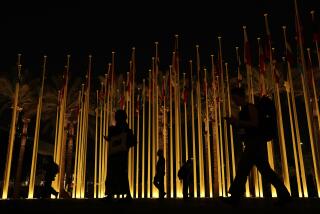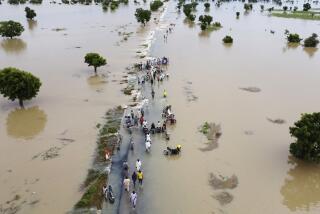Earth Summit: The Green Issue Will Be Cash
WASHINGTON — Two-and-a-half years in the making, a blueprint for grappling with global environmental problems has been distilled into an 800-page document that is “the most extensive and comprehensive international program ever developed and approved word by word by governments,” as one booster said.
But instead of launching a new era of environmental progress, Agenda 21 may touch off a bruising battle at the upcoming Earth Summit in Rio de Janeiro because one critical issue remains unsettled: money.
No agreement has been reached on how much industrial nations like the United States will have to pay to make the new blueprint a reality. And sharp disputes still exist over how to channel the money if it is provided.
Both issues now must be taken up at the 160-nation, United Nations-sponsored summit in June, and it threatens to turn the gathering into an angry showdown between the haves and have-nots.
Not surprisingly, the price tag for Agenda 21 is as breathtaking as the goals are flashy, sweeping as they do from population control and sewage disposal to protection of the atmosphere and mountain ecosystems, conservation of ocean resources and management of biotechnology.
Although 10% to 15% of the agenda reaching into the next century is yet to be completed, estimates by the summit secretariat put the implementation costs through the rest of this decade at about $600 billion annually.
Of that, the staff of the U.N. Conference on the Environment and Development, as the summit is formally called, estimates that $125 billion in new international financing would be required annually--more than double all of the bilateral and multilateral development assistance provided by industrial nations in 1990.
But the debate over the money and how it is to be managed does not end with Agenda 21. Financing arrangements are yet to be worked out for two other global agreements still being negotiated: a climate-change convention addressing the threat of global warming and an agreement mandating far-reaching steps to preserve the world’s biological diversity.
Like the programs in Agenda 21, both the climate and biological conventions would require industrial countries of the Northern Hemisphere to provide the developing countries of the Southern Hemisphere with hefty assistance to control pollution and conserve natural resources while striving for economic self-sufficiency.
In addition to the new funding called for in the agreements that summit sponsors want to sign in Rio, industrial countries will be asked to reaffirm a U.N. goal of increasing overseas development assistance to 0.7% of their gross national products by the year 2000.
While the United States ranks second among the nations of the Organization for Economic Cooperation and Development in dollars spent on overseas assistance, 1989 statistics put it dead last among them when its assistance was calculated as part of its GNP. Its outlay of $7.66 billion amounted to 0.15%.
In contrast, the Scandinavian countries of Norway and Sweden give 1.04% and 0.97% respectively, although the dollar amounts are far lower than that of the United States.
Such statistics make Washington a target of critics from both developing countries and environmental activists.
With the controversy coming to a head during an election campaign and with the United States struggling to get out of its stubborn recession, the prospect of being a prime target in a North-South imbroglio over environmental and development funding has made President Bush skittish about even showing up at the conference.
While its industrial partners are calling for a provision requiring that emissions of carbon dioxide be stabilized at 1990 levels by the year 2000, the Bush Administration has steadfastly refused to go along.
The Administration is concerned about the economic impact of reducing the use of the fossil fuels that create the principal pollutant associated with the “greenhouse effect”--a phenomenon that some scientists believe could lead to a dangerous warming of the global climate.
Anticipating a broadside from Arkansas Gov. Bill Clinton, the likely Democratic presidential nominee, for his failure to announce plans to go to the Rio summit, Bush said Tuesday that he would like to attend, but he reiterated his determination not to be “party to a bad deal.”
Not only have the industrial nations of the Northern Hemisphere postponed commitments of specific amounts of money for Agenda 21 and for the climate and biodiversity conventions, negotiators so far have been unable to agree with developing countries on the way increased assistance from the North would be delivered to the South.
To manage the new assistance, industrial countries that are expected to provide most of the new international funding favor using the Global Environmental Facility, administered by the World Bank, the United Nations Environmental Program and the United Nations Development Program.
But in the eyes of many environmentalists and developing countries, the Global Environmental Facility, which is still in a trial period of assisting developing countries with the international problems of global warming, pollution of international waters, destruction of biodiversity and depletion of stratospheric ozone, is seriously handicapped by its relations with the World Bank.
Although in recent years the bank has increased its lending for environmental purposes, begun requiring environmental impact statements for programs that it funds and begun advocating sustainable development, it is suspect in the eyes of environmentalists because it has financed projects resulting in the destruction of rain forests and the displacement of communities by hydroelectric dam projects.
Because of such concerns, developing countries have argued for the creation of a “Green Fund” without ties to the bank.
Despite such concerns and the failure of negotiations to settle on funding arrangements thus far, Maurice Strong, the secretary general of the Rio conference, is optimistic about resolving the financing issue and is exuberant over Agenda 21’s content.
“I expect that we will have a commitment by industrialized countries that represents a credible step forward in meeting the costs of implementing Agenda 21,” he said at the last preparatory meeting before the conference.
Strong had grounds for his optimism.
After long holding out for the establishment of a Green Fund, the original Group of 77 developing countries, which now has grown to 120 nations, dramatically shifted its position.
Near the end of the final summit preparatory meeting, the group proposed that the Global Environmental Facility “serve as an appropriate multilateral mechanism to provide new and additional financial resources” for developing countries.
Had there been time, sources said, agreement might have been reached. But the industrial powers were unable to agree on a position, and there was disagreement on whether the text would say that the facility “could” or “should” be used as the funding apparatus.
In the end, the leaders of the developing countries reverted to their demand for an independent Green Fund.
Trying a new tack at resolving the funding impasse, former Japanese Prime Minister Noboru Takeshita convened a two-day conference in Tokyo last week.
The upshot of the gathering was a statement endorsing the Global Environmental Facility as principal manager of the new funds but calling for it to be “revised and strengthened” and made more democratic. Environmentalists meeting in the Japanese capital at the same time called for a moratorium on projects of the facility until it is reformed.
Although the facility’s sponsors are expected to announce steps to address its critics and the World Bank next week, the prospect for avoiding a funding fight at the summit also hinges on a meeting in Kuala Lumpur, Malaysia.
There, leaders of the developing nations bloc will try for a final time to stake out their position for the climactic negotiations in Brazil.
More to Read
Sign up for Essential California
The most important California stories and recommendations in your inbox every morning.
You may occasionally receive promotional content from the Los Angeles Times.










